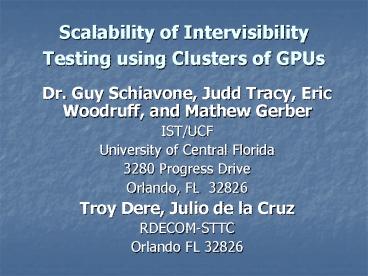Scalability of Intervisibility Testing using Clusters of GPUs - PowerPoint PPT Presentation
1 / 21
Title:
Scalability of Intervisibility Testing using Clusters of GPUs
Description:
We apply Area-of-Interest (AOI) to further cull entities ... Design and Implement Data Structure Optimizations. Greater Employment of CPU ... – PowerPoint PPT presentation
Number of Views:129
Avg rating:3.0/5.0
Title: Scalability of Intervisibility Testing using Clusters of GPUs
1
Scalability of Intervisibility Testing using
Clusters of GPUs
- Dr. Guy Schiavone, Judd Tracy, Eric Woodruff, and
Mathew Gerber - IST/UCF
- University of Central Florida
- 3280 Progress Drive
- Orlando, FL 32826
- Troy Dere, Julio de la Cruz
- RDECOM-STTC
- Orlando FL 32826
2
Commoditization of Computing
- Mass market economics drives Moores Law
exponential increase in performance/cost ratio. - Combining commodity hardware and free-source
software can provide low-cost supercomputing
Beowulf clusters - Graphical Processing Units (GPUs) progressing
even faster (Super Moores Law)
3
Intervisibility Problem in CGF
- Dynamic Entity Interactions a major constraint on
performance in CGF systems - Hypothesis Reducing time of Line-of-sight (LOS)
calls can significantly increase number of
supportable entities in CGF - Idea Combine cluster computing with GPU
co-processing, test scalability.
4
Background
- 1994- Becker, Stirling Beowulf Clusters
- Highly successful for parallel processing
problems with low communication overhead - Late 1990s GPUs used to solve alternative
problems - 1998-2000 Accelerated point visibility queries
(Z-buffer queries) - UNC (Dr. Manocha) Volume rendering, Collision
detection (Optimizing data structures,
coordinating CPU/GPU processing)
5
Our Task
- Compare performance using generic CTDB and
OpenFlight Formats - High-Level API OpenSceneGraph (OSG)
- Free source Extensible, Rapid Prototyping
- Active Community Well Supported, Efficient
Implementation - Forces the use of an Update/Cull/Render paradigm
6
Our Algorithm
- Uses OpenGL extension called NV_Occlusion_Query
(NVidia, ATI, MESA 6.0) - allows query of the graphics hardware of how many
pixels are rendered between the time a begin/end
pair occlusion query call are performed - originally created to determine if an object
should be rendered - our algorithm takes advantage of it to see what
percentage of an entity is actually rendered
7
Update stage
- Update stage of the scene graph is where all data
modifications are made that affect the location
and properties of objects in the scene graph - entities positions and orientations are updated
along with all sensor orientations - scene graph is traversed and the distance between
each sensor and all entities is calculated - algorithm has one call to the Update stage per
time step
8
Cull Stage
- all geometry is checked against a view frustum to
determine if is should be rendered. - We apply Area-of-Interest (AOI) to further cull
entities - For this algorithm the render order is critical
All terrain and static objects should be rendered
first as they will always occlude. - Next all entities and dynamic objects are
rendered in a front to back order (visibility of
entities not occluded by closer objects)
9
Render stage
- All terrain and static objects are rendered first
- Each entity is rendered twice in front to back
order wrapped with NV_Occlusion_Query begin/end
calls - first time an entity is rendered the depth buffer
and color buffers are disabled to obtain the
amount of pixels an entity uses with out being
occluded - entity is rendered again with the depth and color
buffers enabled to obtain the amount of pixels
actually visible - Intervisibility visible pixels/total pixels per
entity
10
Hardware Specs
- Compute Node Dual AMD Athlon 1.33 GHZ, 512 MB
RAM, Fast Ethernet network - GPU - NVIDIA GeForce FX5900 Chipset
- 256MB DDR SDRAM
- 400 MHz engine clock
- 850 MHz memory clock
- 400 MHz internal RAMDAC
- 300 Million vertices/ sec
- 3.6 Billion texels/ sec fill rate
- 27.2 GB/sec memory bandwidth
- 8 pixels per clock rendering engine
11
(No Transcript)
12
(No Transcript)
13
(No Transcript)
14
(No Transcript)
15
(No Transcript)
16
(No Transcript)
17
(No Transcript)
18
Distributed Calculations
- Front end distributes entitles at start in random
order - Preliminary algorithm - No load-balancing
- Load Imbalance ranges from 4 -30
- Current approach Embarrassingly parallel
- Each Node has full database
- Load Balancing optimization must have minimal
communication overhead (global)
19
Load imbalance Example 1 sensor/screen, 1-4
Nodes
20
Conclusions
- Use of multiple GPUs a scalable approach, with
potential performance on the order of OTB - Parallelization/GPU effective, parallelization/scr
een requires geometry LOD adjustment - Approach has potential employment as
Intervisibility Server.
21
Future work
- Implement Load balancing
- Optimize multiple sensor/screen cases by
Level-of-detail adjustments - Extend GPU cluster results to 16
- Design and Implement Data Structure Optimizations
- Greater Employment of CPU

